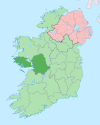Furbo | |
|---|---|
Village | |
| Na Forbacha (Irish) | |
 Hotel and coastal road at Furbo (Na Forbacha) | |
| Coordinates: 53°14′56″N9°12′18″W / 53.249°N 9.205°W | |
| Country | Ireland |
| Province | Connacht |
| County | County Galway |
| Elevation | 15 m (49 ft) |
| Population | 868 |
| Irish Grid Reference | M199288 |
| Na Forbacha is the only official name. The anglicised spellings Furbo and Furbogh have no official status. | |
Furbo or Furbogh (officially known as Na Forbacha in both Irish and English) [2] is a settlement in Connemara, County Galway, Ireland. As of the 2022 census, it had a population of 868 people. [1] It lies along the coast, overlooking Galway Bay, in a Gaeltacht (Irish speaking) area.

